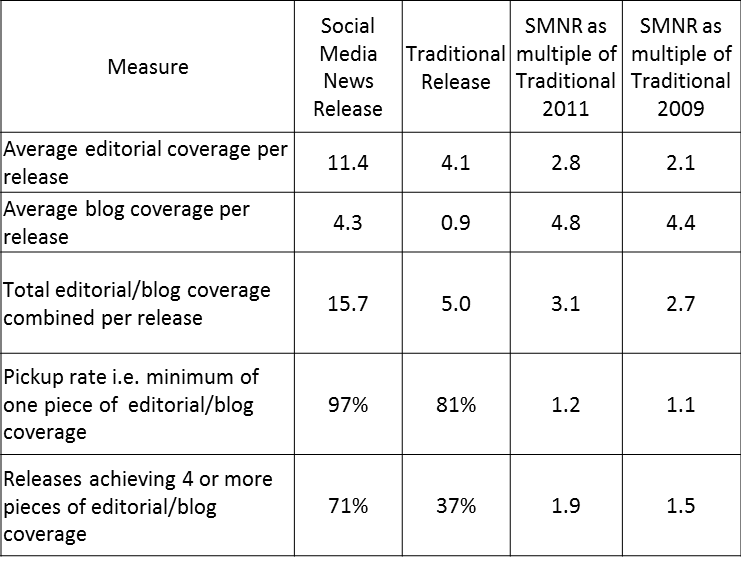In the summer of 2009 we did some analysis looking at whether Social Media News Releases (SMNR) achieved more coverage than “traditional” press releases. The analysis of almost one thousand releases showed that SMNRs distributed by RealWire generated twice the editorial coverage and almost four times the blog coverage.
A few weeks ago whilst discussing the timing of a FIR interview with me on the value of press releases (which is now published here by the way)Â Shel Holtz asked me if I had any plans to update the research. As it had been over 18 months this seemed a good idea so I booted up Excel and here are the results

1,044 releases were analysed from those distributed in the 6 months from September 2010 to March 2011
Coverage is data is based on RealWire’s Proveit coverage tracking and evaluation service
79 were Social Media News Releases (releases related to 62 different companies, across 21 different industry sectors)
965 were “Traditional” Releases (releases related to 339 different companies, across 28 different industry sectors)
So overall the sample of SMNRs achieved over three times as much editorial/blog coverage on average (15.7 pieces v 5.0 pieces) as the “traditional” releases.
Some examples from different sectors of high performing SMNRs include releases by Panasonic, Alterian, 3M, Warner Bros, Rolls Royce and Aviva.
As with the previous analysis I think one of the primary reasons for the difference in performance is that the additional investment that can often be required to produce an SMNR – multimedia assets, links to background research etc – means that they are used for stories that the sender perceives are potentially high impact and therefore likely to be of interest to a wide audience.
Another reason could be the lower proportion of B2B releases in the SMNR sample. However I am not necessarily convinced this is the case as there are plenty of examples of B2B releases in the traditional sample that performed to a similar level as the best performing B2C SMNRs.
As I indicated in my interview with Shel I think it is more likely that a higher proportion of traditional releases are more informative in nature e.g. new appointment, new customer, financial results, tradeshow attendance etc. These stories are of potential value to relevant publications, but it is likely that the number of such publications will be lower than where the release is around a broader topic of conversation e.g. research, market changes, new products etc. If people would find this of interest then let me know in the comments as further study of the nature of the releases themselves might shed some more light.
In the meantime on a short promotional note it is good to see that our overall pickup stat of 80%+ of releases gaining editorial/blog coverage still compares very favourably with our competition ![]()
